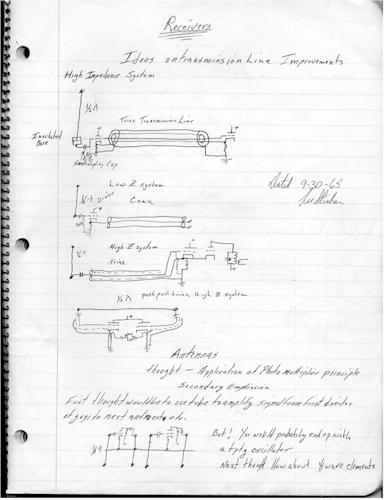

8125 SW Larch Dr.
Culver, Oregon USA 97734
Hi-Z Antennas was started by Lee Strahan K7TJR of Culver Oregon. Sometime around 1964 while working for the University of California Lawrence Radiation Laboratory I ran across a data acquisition system that used a unity gain amplifier to bootstrap the inner shield of a triaxial cable. A very high impedance system.

Yes, this is a piece of circuit board etched with the circa 1963 logo.
The center conductor of the cable carried a signal derived from a piezoelectric vibration measuring accelerometer of very high impedance. This worked very well with the low frequency signals coming from the accelerometer which had a mostly capacitive source impedance. The idea struck me that why couldn't I use this with an antenna or transmission line. Well, it did not work and I succeeded in building a really great oscillator.
Original Personal Design log book ca. 1965

Yes, those are vacuum tube symbols! Notice the comment about oscillation.
The idea stuck with me for many years as I worked into design engineering. It began to stir my curiosity again as I was designing high impedance FET buffers for use in signal generating bench equipment. My first high impedance receiving antenna used the FET buffer circuitry of an Exact Electronics Inc model 7060 function generator. Yes I was on the design team and the 3 foot tall voltage probe type antenna was on the corner of my engineering bench for many years. After taking the successful cure for the VHF repeater building disease, I was visiting my long time friend K7ZUM while a 160 meter contest was in process. I was doing fine until I heard my first JA station on 160 meters and I was immediately struck with the oft celebrated top-band disease.
Fast forward with retirement and years of research into such things as the 96 element Wullenwever antenna, I published my work on a unique new 8 element receiving antenna on www.k7tjr.com along with my much refined design for a Hi-Z amplifier. The 8 element array was the hardest to get to work. In the process of developing the 8 element array, several smaller arrays of 1, 2, and 4 elements were constructed to ground myself and get back to basics. The 4-square array remains the easiest to build with the best low noise performance for the area needed. I have since also designed and published the information for constructing a really small back yard directional antenna, the three element array. These antennas really do work. Many requests for information and Hi-Z amplifiers necessitated the beginning of Hi-Z Antennas the business and www.hizantennas.com .
Receiving improvement on 160 meters is really hard to get. Each improvement is like peeling the layers off an onion. A little improvement shows the direction for a little more. I think I have reached the pinnacle for the environment I have to work with, but then one never knows. One thing for certain, no more vacuum tubes.
Thanks for looking. Lee
amateur radio station K7TJR since 1962